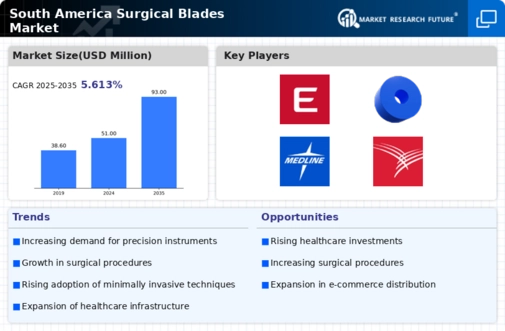Surge in Surgical Procedures
The surge in surgical procedures across South America significantly impacts the surgical blades market. With an increase in the prevalence of chronic diseases and an aging population, the demand for surgical interventions is on the rise. For example, the number of surgeries performed in Argentina has increased by over 15% in recent years, indicating a robust growth trajectory. This trend is likely to continue, as advancements in surgical techniques and technologies encourage more patients to opt for surgical solutions. Consequently, the surgical blades market is expected to experience heightened demand, as healthcare providers require reliable and efficient surgical instruments to meet the needs of an expanding patient base.
Increasing Healthcare Expenditure
The rising healthcare expenditure in South America is a pivotal driver for the surgical blades market. Governments and private sectors are investing more in healthcare infrastructure, which includes surgical facilities. For instance, Brazil's healthcare spending has seen an increase of approximately 10% annually, reflecting a growing commitment to improving surgical services. This trend is likely to enhance the demand for surgical blades, as more surgeries are performed in hospitals and clinics. Additionally, the expansion of healthcare facilities in urban and rural areas is expected to further boost the market. As surgical procedures become more accessible, the surgical blades market is poised for growth, driven by the need for high-quality surgical instruments that meet the increasing volume of surgical interventions.
Growth of the Medical Device Sector
The growth of the medical device sector in South America serves as a crucial driver for the surgical blades market. The region has witnessed a notable increase in the production and distribution of medical devices, with a projected growth rate of around 8% annually. This expansion is attributed to both local manufacturing initiatives and the influx of international companies seeking to establish a presence in the market. As the medical device sector flourishes, the demand for surgical blades is likely to rise in tandem, as these instruments are essential components of surgical procedures. Furthermore, the collaboration between local manufacturers and global players may enhance the quality and availability of surgical blades, thereby positively influencing the market.
Rising Awareness of Surgical Safety
Rising awareness of surgical safety among healthcare professionals and patients is increasingly influencing the surgical blades market. As surgical safety protocols become more stringent, the demand for high-quality, sterile surgical blades is expected to grow. Educational campaigns and training programs focusing on surgical safety have gained traction in South America, leading to a heightened emphasis on using reliable surgical instruments. This trend is likely to drive healthcare providers to invest in superior surgical blades that meet safety standards. Consequently, the surgical blades market may experience growth as hospitals and clinics prioritize patient safety and quality in surgical procedures.
Technological Innovations in Surgical Instruments
Technological innovations in surgical instruments are transforming the landscape of the surgical blades market in South America. The introduction of advanced materials and designs, such as disposable and safety blades, is enhancing the performance and safety of surgical procedures. For instance, the adoption of blades with improved ergonomics and coatings is becoming more prevalent, as they offer better precision and reduce the risk of complications. This trend is likely to attract healthcare providers seeking to improve surgical outcomes. As technology continues to evolve, the surgical blades market is expected to benefit from the integration of innovative solutions that cater to the demands of modern surgical practices.


















Leave a Comment